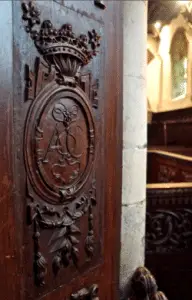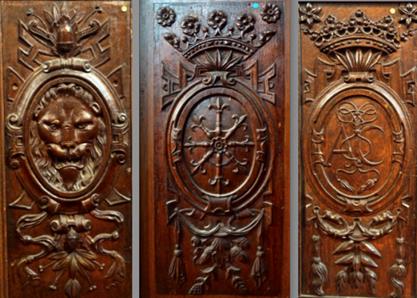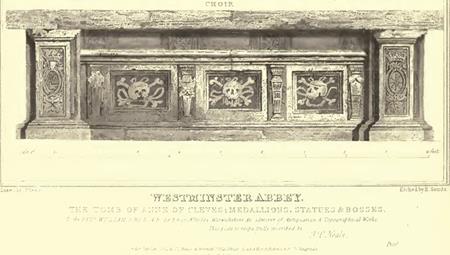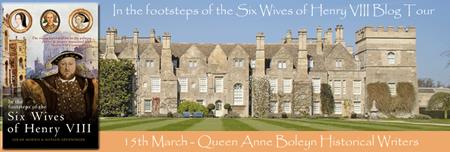 A big welcome to author Sarah Morris who has joined us today as part of the book tour for In the Footsteps of the Six Wives of Henry VIII co-authored with Natalie Grueninger.
A big welcome to author Sarah Morris who has joined us today as part of the book tour for In the Footsteps of the Six Wives of Henry VIII co-authored with Natalie Grueninger.
Congratulations to both Sarah and Natalie on the release of their new book. Their first book In the Footsteps of Anne Boleyn was excellent so this new book is a must-read!
Giveaway – Amberley Publishing is offering a copy of In the Footsteps of the Six Wives of Henry VIII to one lucky Anne Boleyn Files visitor. All you have to do is comment below this post stating which Tudor place associated with Henry VIII’s six wives you’d like to visit. Please leave your comment by midnight on 23rd March 2016. One comment will be picked at random and the winner contacted for their details.
Over to Sarah…
I love a good adventure! Little could I have believed that perhaps the most overlooked of all of Henry’s wives was about to take me on my most thrilling odyssey yet. During the course of my research into the early life of Anne of Cleves, I came across a chance mention of a set of carved, oak panels, currently in situ in St Leonard’s Church, Old Warden, Bedfordshire. Scanty references and the odd photo from previous amateur time travellers had been logged online, along with the tantalising reference that these panels had been salvaged from ‘Anne of Cleves’ chapel in Bruges’.

Although Pevsner had dismissed the claim outright, stating in his book, Buildings of England: Bedfordshire, Huntingdon and Peterborough (p.131), ‘What has Anne of Cleves got to do with Bruges?’; I at least knew the answer to that question and was too intrigued to let the statement pass me by without further investigation. Perhaps this local folklore was also a clue to her long-lost lodgings in the city?
During the atrocious northern winter of 1539/40, Anne had passed through Bruges on the journey from her homeland to England. She was to marry Henry VIII and become the capricious king’s fourth wife. The visit was fleeting; the royal entourage staying just one night in early December 1539. The sole reference to the event in the local archives was that a merchant had been paid by the city to deliver wine to ‘the daughter of Cleves being within the city to travel to England in December’. And so, whilst the hunt for Anne’s lodgings in Bruges got underway, once I had returned from Belgium, I turned my attention to the panels. Here began a whole sequence of synchronicities that surely must make a person question whether indeed unfathomable and invisible forces are sometimes at work behind the scenes.

One of my first stops was the local archive in Bedford. Unbeknownst to me, as I spoke with the archivist over the telephone, a local historian, who had a particular interest in Old Warden and its nineteenth century squire, overheard one side of the conversation. Sometime after the event, Christine (Hill) would recount how her ears had pricked up with inevitable interest at the mention of ‘Anne of Cleves’ and ‘Old Warden Church’. Within weeks we would be together in person, pouring over the carvings in question amidst the quiet stillness of St Leonard’s Church; Christine sharing her knowledge of Lord Ongley, who had apparently salvaged the carvings from the continent, and me, of Anne of Cleves and her connection with Bruges – and the possible contenders for her city lodgings.
Through Christine, I soon found out that the set of twenty-two panels of three separate designs (see images) had been examined over the last 130 or so years by various professional and amateur commentators alike. Over and above Pevsner’s outright dismissal, disparate conclusions had been drawn about their origins, with France, the Low Countries and England all being variously mentioned as the country of origin, whilst the dating of the panels ranged from the sixteenth and eighteenth centuries to nineteenth century replicas. I couldn’t help but think of Churchill’s phrase; it seems we had a ‘riddle wrapped in an enigma’ on our hands, and it was fast becoming clear to me that enthusiasm alone would not unlock the secrets of the carvings. We needed to bring to bear all the latest scientific and historical expertise if we were to have a hope of getting to the bottom of the mystery.

Whilst pondering how to bring this about, we had a breakthrough. Christine uncovered the fact that the three different designs on the panels were identical to those oval cartouches carved into Anne of Cleve’s tomb in Westminster Abbey. As far as we know, this connection had been lost to living memory, and for the first time we were able to sweep conjecture aside. There was now no doubt that these carved panels were directly related to England’s queen. It was a significant breakthrough, but by this time, I knew one thing for sure – I was way out of my depth! With this in mind, I contacted Jonathan Foyle, experienced architectural historian and ex-curator of Hampton Court Palace, who many of us will have enjoyed watching pore over the foundation stones of various Tudor houses and palaces in Channel 4’s Time Team. I needed to know the origins of the carvings; were they contemporary or copies? Jonathan’s interest was piqued, having only recently researched and placed a discarded oak bed as being the wedding bed of Henry VII and Elizabeth of York. Another carved interior with unqualified provenance was definitely his kind of problem.

Some weeks later, Christine and I had raised the funds to allow the project to proceed. Our little team, which by that time had expanded to include not only Jonathan, but also Helen Hughes, a specialist in the forensics of early historic decoration, arrived at the church on one rainy, March morning in 2015. We were nervously expectant as Helen donned her magnifying glasses in order to identify, and scrape away, tiny deposits of ‘grunge’ from the panels. We hoped that these samples would contain microscopic flecks of paint consistent with pigments used in the sixteenth century. At the same time, Jonathan pored over the visual evidence.
Disappointingly, initial results indicated that the panels looked to be later copies; the wood was too fresh and there was no sign of the paint pigments that would have indicated a sixteenth century origin. For a time, our quest seemed to be at an end and we reluctantly concluded that they must have been revivalist copies, made for an eccentric English gentleman, who had more than a passing interest in Tudor history.
Then, no more than eight weeks later, a second synchronicity occurred – and it changed everything. It caused us fundamentally to question our original findings, throwing a whole new perspective on the likely origin and history of the panels. A separate, single panel came up for auction at Bonhams in May 2015. The panel was identical to one of the designs in St Leonard’s Church; an oval cartouche containing the AC monogram, surmounted by a coronet. It was an unbelievable co-incidence! The appearance of the panel opened up new vistas of possibility. New visual evidence of the state of the panel would take us down a different road, and if Jonathan’s hypothesis was correct, it would mean that the panels were indeed linked directly to the personal domestic environment of Anne of Cleves, and if so, the find would be extraordinarily rare. The enigma finally began to surrender its secrets…
The full story and its conclusions can be found in, In the Footsteps of the Wives of Henry VIII, in a section dedicated to ‘The Anne of Cleves Panels’.
Do make sure that you visit the other stops on Sarah’s and Natalie’s tour. Here is the schedule:

- 15 March – Queen Anne Boleyn Historical Writers – The Power of Places (Article)
- 16 March – Here!
- 17 March – Queen to History – Katherine of Aragon (Extract)
- 18 March – Nerdalicious – The Making of an English Queen (Article)
- 19 March – Tudor Times – Q & A with Natalie Grueninger
- 20 March – Through the Eyes of Anne Boleyn – A Royal Procession and the Frozen Thames (Article)
- 21 March – Lady Jane Grey Reference Guide – Rye House (Extract)
- 22 March – Tudor History.org – May the Force be With You (Article)
About the Authors

Natalie Grueninger is a researcher, writer and educator, who lives in Sydney with her husband and two children.
She graduated from The University of NSW in 1998 with a Bachelor of Arts, with majors in English and Spanish and Latin American Studies and received her Bachelor of Teaching from The University of Sydney in 2006.
Natalie has been working in public education since 2006 and is passionate about making learning engaging and accessible for all children.
In 2009 she created On the Tudor Trail (http://onthetudortrail.com/Blog/), a website dedicated to documenting historic sites and buildings associated with Anne Boleyn and sharing information about the life and times of Henry VIII’s second wife. Natalie is fascinated by all aspects of life in Tudor England and has spent many years researching this period.
Her first non-fiction book, co-authored with Sarah Morris, In the Footsteps of Anne Boleyn, was published by Amberley Publishing and released in the UK in late 2013. Natalie and Sarah have just finished the second book in the series, In the Footsteps of the Six Wives of Henry VIII, due for publication in the UK on 15 March 2016 and on Amazon US on 19 May 2016.
You’ll find Natalie on Facebook (https://www.facebook.com/OntheTudorTrailRetracingthestepsofAnneBoleyn/), Twitter (https://twitter.com/OntheTudorTrail) and Instagram (themosthappy78).

Sarah is a creative soul, as well as an eternal optimist who generally prepares for the worst! She is an advocate of following the heart’s deepest desire as a means to finding peace and happiness. To this end, her writing is a creative expression of her joy of both learning and educating.
Drawn by an inexplicable need to write down the story of Anne Boleyn’s innocence, she published the first volume of her debut novel, Le Temps Viendra: a novel of Anne Boleyn in 2012; the second volume followed in 2013. That same year, her first non-fiction book, co-authored with Natalie Grueninger called, In the Footsteps of Anne Boleyn, was also published. Hopelessly swept away by an enduring passion for Tudor history and its buildings, her latest book, the second of the In the Footsteps series entitled, In the Footsteps of the Six Wives of Henry VIII, is due to be published by Amberley Publishing in the UK on 15th March 2016 and in the US on 19th May.
She lives in rural Oxfordshire with her beloved dog and travelling companion, Milly.
You’ll find Sarah at www.letempsviendra.co.uk, or via her blog, This Sceptred Isle: https://letempsviendra.wordpress.com/.
Buy In the Footsteps of the Six Wives of Henry VIII from:
Amazon UK
Amazon US (Released on 19 May 2016)
The Book Depository (Free worldwide shipping)